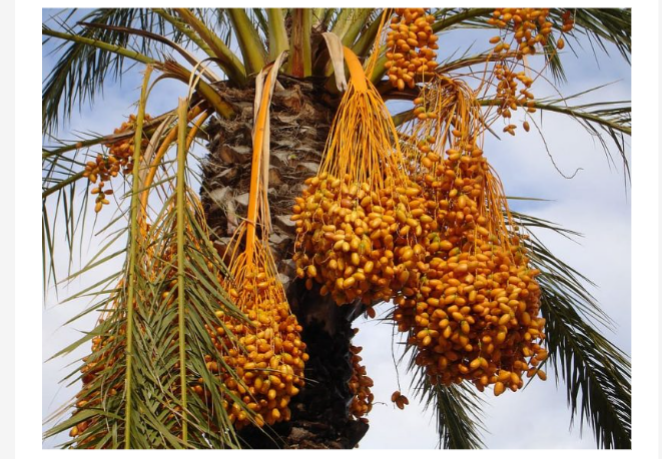
Date palm, Phoenix dactylifera L.,is an angiosperms (Monocotyledonous) plant that belong to the family Palmaceae. There are about 200 genera and 1, 500 species of date in this family . All of these species are native to the tropical or subtropical regions of Africa or Southern Asia, including Phoenix dactylifera.
The name “phoenix” is derived from a Phoenician name which means date palm, and “dactylifera” derived from a Greek word “daktulos” meaning a finger, illustrating the fruit’s form.
BENEFITS OF DATE PALM
1. Date fruit is rich in nutrients, and due to its dietetic values it has always been held in high esteem by people. Compared to other fruits and foods, dates give more than 3,000 calories per kilogram. The date fruit consists of 70 % carbohydrates (mostly sugars), making it one of the most nourishing natural foods available to man. The water content is between 15 to 30 % depending on the variety and on the maturity stage of the fruit.
2. The date palm is one of the greatest producers of food per hectare, and world date production is well over 3 million tons.
3. The sugar content of varieties of date fruit is almost entirely of the inverted form (namely glucose and fructose), important for persons who cannot tolerate sucrose. The invert sugar in dates is immediately absorbed by the human body without being subjected to the digestion that ordinary sugar undergoes.
4. The flesh of dates contains 60 to 65 % sugar, about 2.5 % fibre, 2 % protein and less than 2 % each of fat, minerals, and pectin substances. 5. Date fruits are also a good source of iron, potassium and calcium, with a very low sodium and fat content. In addition, moderate quantities of chlorine, phosphorous, copper, magnesium, silicon and sulphur are also found in the date fruit.
6. Date fruit is called a mine in itself because it is very rich in minerals. Its phosphorous content is similar to that found in the same quantity of apricots, pears and grapes put together.
7. Its high content of magnesium (±600 mg/1kg of dates) could also be very beneficial. Date consumers in Saharan areas are known to have the lowest rate of cancer diseases, a fact attributed to the magnesium found in dates.
8. With only 1 mg of sodium per 100 g, dates are good food for those on a low sodium diet. The iron content of 3 mg per 100g is almost a third of the Recommended Dietary Allowance for an adult male.
9. Note that fibre, even though it is not a nutrient for humans, is of much value in a diet as an aid to digestion and evacuation. There is ample evidence that for most persons a diet fairly high in fibre is healthier than one low in fibre.
10. Furthermore, dates are a good source of vitamins A, B1 (thiamine), B2 (riboflavin), and B7 (nicotinic acid also called niacin). The following contents per kilogram are an average for all date varieties: vitamin A, 484 international units; B1, 0.77 milligram (mg); B2, 0.84 mg; and B7, 18.9 Mg. 11. Dates are especially delicious as a fresh fruit. When used in baking they provide superb taste to the final product.
12. Dates are also used as a component in food preparations like sweets, snacks, confectionery, baking products, institutional feeding and health foods.
13. Listed below is a brief summary of the main date products:
14. They are also used for Home-made products like: Pastry, bakery, confectionery products, beverages, salads, Dehydrated dates, date flour (dietetic baby foods), cereals, almonds and nuts,
15. It is also used for making Sweets and snacks (date nut roll), Chocolate-coated and stuffed dates (with nuts), Date jams, date butter or cream, Date preserves and cardiments, caramel products and Date desserts.
NUTRIENT COMPOSITION OF DATE
{According to Genske and Weers, (1973)}
one kilogram of the flesh of ripe dates contains the following: water (220g), sugar (730g; 2740 calories), proteins (22g), Fats (2g) and minerals (19g,) K 6480mg), P (630mg), Ca (590mg), Mg (580mg), Fe (30mg) and Na (10mg)), vitamin A (500 units), vitamin B1 (0.9mg), vitamin B2 (1mg) and vitamin B7 (22mg)
BOTANY OF DATE PALM
a. TRUNK :
The date palm trunk is also called stem or stripe, is vertical, cylindrical and columnar of the same girth all the way up. The girth does not increase once the canopy of fronds has fully developed. It is brown in colour, lignified and without any ramification. It has an average circumference of about 1 to 1.10 m.
The trunk is covered for several years with the bases of the old dry fronds, making it rough, but with age these bases weather and the trunk becomes smoother. Vertical growth of date palm is ensured by its terminal bud, called phyllophor, and its height could reach 20 metres.
b. LEAVES : The leaves of date palm are called fronds. The fronds are needle-like in shape .An adult date palm has approximately 100 to 125 green leaves with an annual formation of 10 to 26 new leaves. Depending on variety, age of a palm and environmental conditions, leaves of a date palm are 3 to 6 m long (4 m average) and have a normal life of 3 to 7 years. The frond midrib also called petiole is relatively triangular in cross section with two lateral angles and one dorsal. It is bare of spines for a short distance but full of spines on both sides thereafter. Intermediate zones have spine-like leaflets, also called leaflet-like spines.
At the tip of the leaf, there may be a single terminal leaflet or two leaflets forming a V. Leaf structure is variety and environment dependent.
Varieties of date can be differentiated based on the characteristics found on their leaves. Unlike other fruit trees, dead or old leaves are not shed and do not drop on their own, but are removed under cultivation.
The functional value of the leaf to the palm declines with age and no two leaves are the same age. Leaves which are four years old are only about 65 percent as efficient in photosynthesis per unit area, compared to leaves of one year old . Under good cultural conditions a leaf can support the production of 1 to 1.5 kg of dates.
CATEGORIES OF DATE LEAVES
Depending on the position of the leaves in the palm’s canopy, date leaves could be divided into 3 categories:
i. -On the outside, leaves are green and photosynthically active. They make up 50 % of the whole leaves.
ii. At the centre, fast growing green leaves. They make up 10 % of the whole leaves
iii. On the inside, at the palm’s heart, juvenile leaves, not yet photosynthetic with a white colour. On average, there are 40 % of juvenile leaves of the whole leaves.
Leaves of seedling date plants are characterised by a slightly developed petiole and a juvenile leaf which develops during the first three years after seed germination . These leaves are also called primordia, non-pinnae or entire leaves.
At the base of each leaf, there is an axillary bud which could yield an inflorescence at the palm’s top level or an offshoot at its base.
c. FIBRE , SPINES AND LEAFLETS
The base of the frond is a sheath encircling the palm. This sheath consists of white connective tissue ramified by vascular bundles. As the frond grows upwards, the connective tissue largely disappears leaving the dried, and now brown, vascular bundles as a band of tough, rough fibre attached to the lateral edges of the lower part of the midribs of the fronds and ensheathing the trunk. Varieties differ in the height to which the fibre grows up the central column of unopened fronds, and in the texture of the fibre and also somewhat in colour.
Spines, also called thorns, vary from a few cm to 24 cm in length and from a few mm to 1 cm in thickness. They are differentially arranged on the two outer edges of the fronds while their number varies from 10 to about 60. Spines can be single, in groups of two, or in groups of three.
Leaflets or pinnae are between 120 to 240 per frond, entirely lanceolate, folded longitudinally and oblically attached to the petiole. Their length ranges from 15 to over 100 cm and in width from 1 to 6.3 cm. Their arrangement depends on variety and could be in groups of 1, 2, 3, 4, or 5 pinnae.
d. REPRODUCTIVE ORGANS
Date palm is a dioecious species with male and female flowers being produced in clusters on separate palms. These flowering clusters are produced with axils of leaves of the previous year’s growth. In rare cases both pistillate and staminate flowers are produced on the same spike while the presence of hermaphrodite flowers in the inflorescence has also been reported. Palms which carry both unisexual and hermaphrodite flowers are known as polygamous.
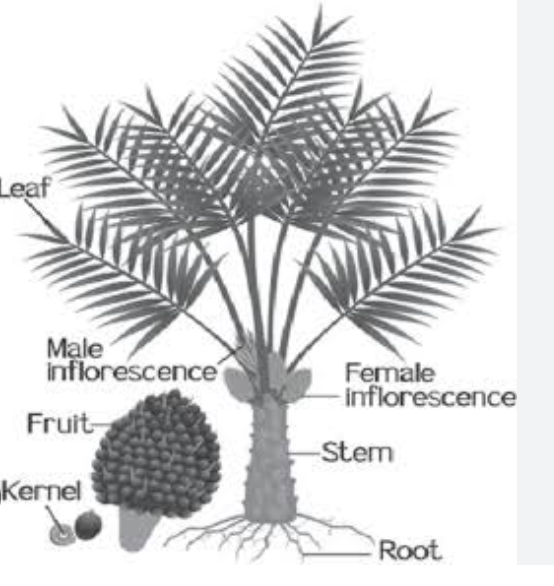
The unisexual flowers are pistillate (female) and staminate (male) in character; they are borne in a big cluster (inflorescence) called spadix or spike, which consists of a central stem called rachis and several strands or spikelets (usually 50 – 150 lateral branches).
e. INFLORESCENCES OR FLOWERS
The inflorescence, also called flower cluster, in its early stages is enclosed in a hard covering/envelope known as spathe which splits open as the flowers mature exposing the entire inflorescence for pollination purposes. The spathe protects the delicate flowers from being shrivelled up by the intense heat until these are mature and ready to perform their function. The spathe at the beginning is greenish, becoming brown when near splitting – splitting is longitudinal. The male spathes are shorter and wider than the female ones. Each spikelet carries a large number of tiny flowers as many as 8,000 to 10,000 in female and more in male inflorescence. The annual number of spathes born by a palm varies from none to about 25 in females and to even more in males, but the average is a dozen for females and more for males. The male inflorescence is crowded at the end of the rachis, while branches of the inflorescence of the female cluster are less densely crowded at the end of the rachis. These characteristics allow the recognition of the inflorescence’s sex before its opening. The male flower is sweet-scented and normally has six stamens, surrounded by waxy scale-like petals and sepals (3 each). Each stamen is composed of two little yellowish pollen sacs.
The female flower has a diameter of about 3 to 4 mm and has rudimentary stamens and three carpels closely pressed together and the ovary is superior (hypogynous). The three sepals and three petals are united together so that only tips diverge. On opening the female flowers show more yellow colour while the male ones show white colour dust, produced on shaking. The pollen sacs usually open within an hour or two after the bursting of the spathe.
Only one ovule per flower is fertilised, leading to the development of one carpel which in turn gives a fruit called a date; the other ovules aborted. The aborted carpels persist as two brown spots in the calyx of ripe fruits.
f. FRUIT : The date fruit is a single, oblong, terette, one-seeded berry, with a terminal stigma, a fleshy pericarp and a membranous endocarp (between the seed and the flesh)
Fruit characteristics vary based on certain factors such as :types of variety, environmental conditions and the technical care given (fertilisation, pollination, thinning, pruning, dethorning etc. ),
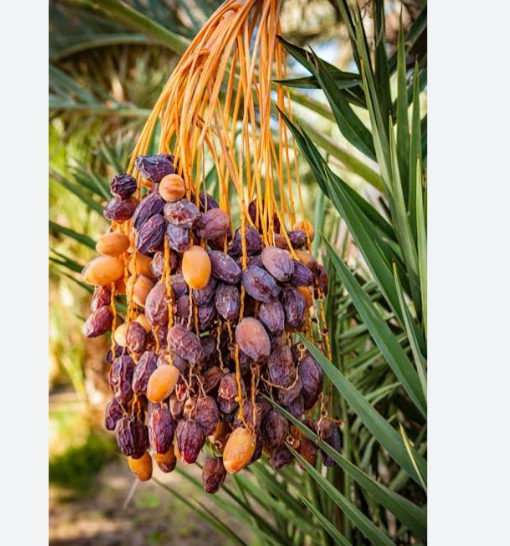
g. SEED : Like the fruit, seed characteristics also vary according to variety, environmental and growing conditions. A seed’s weight could range from less than 0.5 g to about 4 g, in length from about 12 to 36 mm and in breadth from 6 to 13 mm. The seed is usually oblong, ventrally grooved, with a small embryo, and with a hard endosperm made of a cellulose deposit on the inside of the cell walls.
h. VARIETY : There are different Date palm varieties all over the world. There are more than 3,000 varieties all around the world. Two of the varieties include: Medjool and Barhee, which have a high marketing potential.
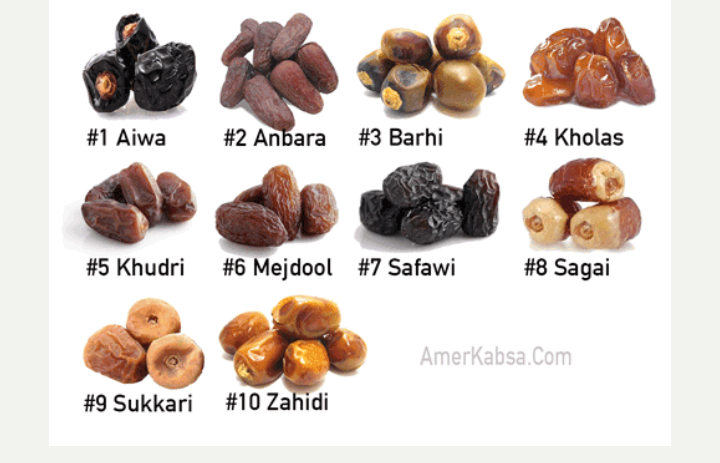
CLIMATIC REQUIREMENT OF DATE PALM
Temperature, rain, humidity, light and wind are the most important climatic factors which determine the suitability of a specific site for growing date palm.
1. TEMPERATURE REQUIREMENTS : date palm is a thermopile species. The highest maximum temperatures found in the date growing areas of the world are the result of low humidity, great insolation and long days in summer or low rainfall. Temperature requirement in the growing areas varies for date production. The average annual temperature range among these areas is between 21°C to 32°C.
In arid and semi-arid regions which are characterised by long and hot summers /or low rainfall and very low relative humidity level during the ripening period. Exceptional high temperatures (± 56°C) are well endured by a date palm for several days under irrigation. During winters in temperate regions, temperatures below 0°C are also endured. The zero vegetation point of a date palm is 7°C, above this level growth is active and reaches its optimum at about 32°C. The growth will continue at a stable rate until the temperature reaches 38°C/40°C when it will start decreasing.
Below 7°C growth stops and this stage is called a resting period. When the temperature decreases for a certain period to below 0°C, it causes metabolic disorders which lead to partial or total damage of leaves. At -6°C pinnae margins turn yellow and dry out. Inflorescences are also heavily damaged by frost. When frost periods are suspected, inflorescences should be protected. From -9 to -15°C, leaves of medium and outside canopy will be damaged and dry out. If these low temperatures are maintained for a long period (12 hours to 5 days) all leaves will show frost damage and the palm will look as if it was burnt. The more leaves damaged, the greater the possibilities of poor fruit quality that year. Poor flowering could also be expected.
After frost occurrence and during early spring or rain, the damaged palm restarts its normal growth. If date farms are irrigated during frost periods less damaged will occur than the ones that were not irrigated.
In summary, the growth of a date palm does not cease if:
(i) minimum daily temperature does not fall below freezing point, and
(ii) maximum daily temperature at the growth centre does not fall below 9 to 10°C.
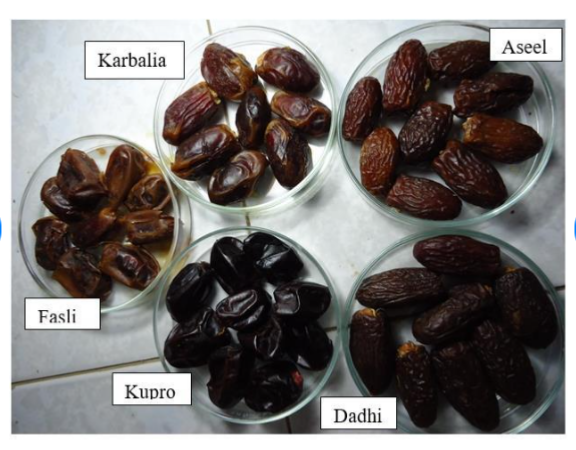
c. RAIN EFFECT : Rainfall does not cause harm to the date fruits, but benefits the soils of the plantations by lessivating the deposited surface salt and avoiding the upward movement of salt from lower layers. In date-growing regions which are almost rainless until November, harvest begins mid August until the end of October. Rain during the flowering and harvest season is likely to cause some damage to the fruits.
Rain can affect pollination in date palm by washing away most of the applied pollen. Another negative effect of rain on fruit set also results from low temperatures that accompany or follow rain. A third factor is the reduction of the flower’s receptivity when in contact with water.
Rain is also responsible for increasing the relative air humidity creating favourable conditions for cryptogamic diseases that result in the rotting of inflorescences. A light spring shower with A high relative humidity followed by warm temperature just before pollination causes the Khamedj disease (Mauginiella schaettae) outbreak. This high relative humidity is also associated with the pollen’s explosion. The major damage caused by rain occurs when either the rain is early, or the dates are late in ripening. In fact, rain does not seriously damage the dates when they are still at the early Khalal stage, but rather has a beneficial effect by washing away all dust and sand particles from the fruits. Rain can however cause severe checking and cracking in the Kimri and late Khalal stages
d. AIR RELATIVE HUMIDITY :
Depending on air humidity at the locality of a date palm plantation, various advantages and/or disadvantages are found. In fact, the date palm eco-system is mostly of an arid nature where air relative humidity has a large influence.
When the air humidity is high, some leaf diseases, such as Graphiola leaf spot (Graphiola phoenicis.), becomes more prevalent, while others, such as the Date mite (Bou-Faroua), become rare or absent. On the other hand, when air humidity is low, fungal diseases are absent, while pest and mite attacks are dominant.
Air humidity also affects the date quality during the maturation process. At high humidity, fruits become soft and sticky, while at low humidity they become very dry. This phenomenon is strengthened when low humidity is coupled with hot and dry winds.
Dry and hot winds cause a rapid maturation process leading to fruit desiccation and the appearance of a yellow or white ring at the fruit base.
When air humidity is high during hot weather, the skin of the date fruit shows several cuts or breaks with an edge-blackening (Blacknose), the soft fruits fall to the ground and consequently lose their commercial value. These effect occurs only when high humidity is experienced immediately before the Khalal stage. After the fruit acquires the Khalal colour, checking no longer occurs. After the flesh softens in the Rutab stage, the skin does not break readily upon contact with moisture, but the fruit absorbs moisture and tends to become sticky and more difficult to handle. After the Tamar stage is reached, air humidity causes little damage to the fruit unless it is neglected
e. WIND : Wind has no serious effect on date. Wind is, however, a carrier of dust and sand that adheres to the date fruits in their soft stage (Rutab and Tamar). When the fruits are at their early development stage (green/Habakouk), nearly black-indurated patches are sometimes seen on the fruit because of the wind beating the tender fruits against the hard fronds. Recently planted small offshoots can, however, easily be uprooted by strong winds.
PROPAGATION: Unlike other palms like coconut, oil palm which are propagated by seed, date palm differs in propagation method. There are three techniques to propagate date palm: Seed propagation, offshoot propagation (traditional methods), and the recently developed tissue culture techniques.
a. SEED PROPAGATION
Seed propagation, also called sexual propagation, is useful for breeding purposes. It is not a proper method of date palm vegetative propagation, and should be discouraged for the following reasons:
i. Date palm is a dioecious species with half of the progeny being males and half being females. The sex of the progenies cannot be determined at an early stage, nor fruit or pollen quality prior to flowering until seven years after planting.
ii. Female plants originating from seedlings usually produce late maturing fruits with inferior quality compared to established clonal palms.
iii. Date palms are heterozygous, and thus there will be much variation within the progeny, and desirable characteristics of the parent palm may be lost. Therefore seed propagation will produce two seedling palms which are dissimilar.
iv. Seedlings differ considerably with regard to production potential, fruit quality and harvesting time, making them very difficult to market as one harvest.
v. The reasons “i to iv” result in waste of time, space and money.
Thus, seed propagation is by far the easiest and quickest method of propagation. But due to its diversity, the seed approach could only be useful for breeding purposes.
b. OFFSHOOT PROPAGATION
Offshoot propagation, also called asexual or vegetative propagation, offers the following advantages:
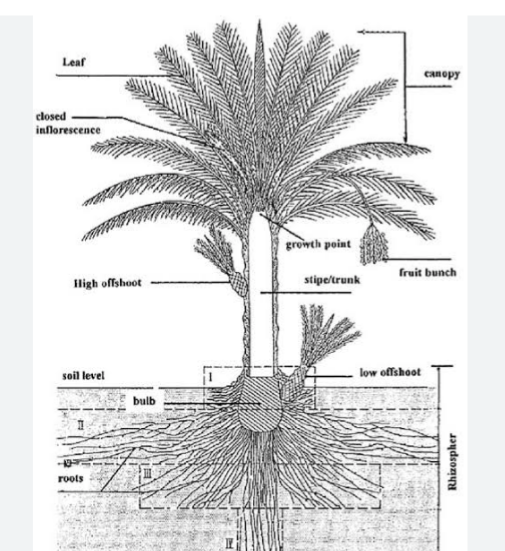
i. Offshoot plants are similar to the parent palm stock. The offshoots develop from axillary buds on the trunk of the mother plant and consequently the fruit produced will be of the same quality as the mother palm and ensures uniformity of produce.
ii. The offshoot plant will bear fruits 2 – 3 years earlier than seedlings. The life span of the date palm is divided into two distinct developmental phases: vegetative, in which buds forming in the leaf axils develop into offshoots; and generative, in which buds form inflorescences and offshoots cease. From the time that the axillary bud of a leaf has differentiated into an offshoot until the time it grows outwards, takes up to three years (18 to 36 months), with another three to four years before it reaches the desired size for its separation and planting
Offshoots are mainly produced in a limited number (20 to 30 at most) during the early life of the palm (10 to 15 years from the date of its planting) depending on the variety and on prior fertilisation treatment, irrigation and earthing up around the trunks.
C. TISSUE CULTURE PROPAGATION : Tissue culture techniques for date palm is also called in vitro propagation. It has many advantages compared to the other two techniques. And has the following advantages :
i. Propagation of healthy selected female cultivars (disease and pest-free), Bayoud resistant cultivars, or males having superior pollen with useful metaxenia characteristics which can easily and rapidly be propagated;
ii. Large scale multiplication;
iii. No seasonal effect on plants because they can be multiplied under controlled conditions in the laboratory throughout the year;
iv. Production of genetically uniform plants;
v. Clones to be propagated from elite cultivars already in existence, or from the F1 hybrids of previous selections, and seed-only originated palms;
vi. Ensure an easy and fast exchange of plant material between different regions of a country or between countries without any risk of the spread of diseases and pests; and
vii. Economically reliable when large production is required.
IRRIGATION : date palm needs sufficient water of acceptable quality to reach its potential yield. Water can be supplied through rain water or irrigation. Certain factors need to be considered when applying water to date palm. Some of which are: Soil salinity, temperature, humidity, wind and cloud cover.
a. Soil salinity: If the soil is saline, more water must be applied to the soil to leach out or clear the salt from the soil.
b. Temperature: The higher the temperature, the higher the rate of evaporation and the more water the plant needs.
c. Humidity: The lower the humidity level, the more water needed.
d. Wind (speed and occurrence): Higher constant wind speeds cause higher evaporation and thus higher water demands.
e. Cloud cover: More water is required during periods of less cloud cover.
Timely watering is important in date palm farming. Watering at late season when the plant is dead is a waste of time and effort. Also, too much water that leads to water logging can result in death of the plant. Most of the roots of date palm are shallow root system located at the top soil with few at the lower soil horizons. Therefore, when Irrigating, the water must be applied where the roots of the plant can easily reach it. That is, close to the root base. This gives reasons why Localised irrigation (e.g. drip and micro) is more efficient than non- localised one (e.g. flood irrigation).
POLLINATION
Date palm is a dioecious plant. The sexes are borne by separate individuals. The unisexual flowers are pistillate (female) and staminate (male). The male palm produces the pollen and the female palm produces the ovary and ovule which develop to form the fruit. The flower stalks are produced from the axils of the leaves in similar positions to those in which offshoots are produced. The inflorescence consists of a long stout spathe which, on bursting, exposes many thickly crowded floral branchlets which are stout and short in male, and long and slender in female. One adult female palm, on average, produces 15 – 25 spathes that contains 150 to 200 spikelets each. The male flowers are borne single and are waxy white, while the female flowers are borne in clusters of three and are yellowish green in colour.
The pollination agents include wind, bees and other insects. But for commercial date production, artificial pollination which ensures good fertilisation and overcomes disadvantages of dichogamy and also reduces the number of male palms usage is more practiced.
FRUIT THINNING: After pollination and fertilisation, the fruits begin to develop enmass.
Fruit thinning is commonly practised in most date growing regions of the world in order to benefit from the following improvements:
a. Avoiding the alternancy phenomenon and ensuring adequate fl owering for the next season. Thinning will allow the palm to produce regularly each year rather than to be weakened during one or two years by a heavy production and causing it to produce small and skinny fruits in the next year.
b. Improving the fruit size and consequently satisfying market preference.
c. Improving the fruit quality and texture which will reflect on the price.
d. Ensuring an early ripening and be first on the market.
e. Early thinning will give room for the development of the fruit and there will be less loss of nutrients (N,P,K.) that have to be replaced by fertilisation.
f. It reduces the weight and compactness of the fruit bunches which will benefit the harvesting and packing operations.
Date fruit thinning may be realised at three levels:
(i) reducing the number of bunches per palm (removal of whole bunches).
(ii) reducing the number of strands per bunch (mostly from the central part of the bunch); and
(iii) reducing the number of fruits per strand (bunch thinning; removal of a proportion from each bunch).
1. BUNCH THINNING: The objective of bunch thinning is to obtain more uniform bunch sizes depending on the fruit set (removal of fl ower strands if the set is poor and vice versa). Bunch thinning helps reduce damage due to humidity by a greater air circulation around the fruits. This ventilation will reduce the risk of later fruit fermentation, rot and sourcing. In some varieties, the reduction of fruits per bunch may increase the susceptibility of fruit to checking (cracking of the fruit skin; minute cracks in the cuticle and epidermal cells) or blacknose (darkening and shrivelling of the tip). Also, early thinning practise increases fruit size. But care must be taken not to overthin. overthinning will increase puffiness and blistering (separation of skin and flesh).
2. BUNCH REMOVAL: when the number of bunch per palm is too high, there is need for bunch removal. An adult date palm could produce 20 or more fruit bunches. In fact, if the number of fruit bunches per palm is not reduced to an appropriate level, the next year’s production will be low, and consequently an alternancy phenomenon is established. Also, bunch removal is carried out to keep a proper balance between the number of leaves and fruit bunches.
The number of fruit bunches for a palm to carry safely depend on its age, size, vigour, variety and the number of good green leaves it carries. Bunch removal is practised immediately after fruit set.
BUNCH LOWERING AND SUPPORT :
For commercial date varieties, after the pollination season, the bunches are pulled downwards through the leaves, gently enough not to break any of the strands, and the bunch fruitstalk is tied for support to the midrib (leaf rachis) of one of the lower leaves to avoid breakage. This practice also makes the bunch easily accessible for thinning, bagging and/or pesticide application. It also prevents damage caused by scarring and shattering of the fruits during high wind, and lessens the later danger of fruitstalk breakage by supporting the bunch as the weight increases.
BUNCH COVERS :
Date palm bunch covers is important to be carried out. This is common in this New World of date culture in order to protect fruits from high humidity and rain, from bird attacks and also from damage caused by insects. Large paper bags, porous cloth or netting are used to cover the fruits. Some of the birds that attack date palm fruits include Redbilled Quelea (Quelea quelea), Redheaded Finch (Amadina erythrocephala), Lesser Blue-Eared Starling (Lamprotornis chloropterus), and the Redeyed Bulbul (Pycnonotus nigricans). The Grey Lourie (Corythaizoides concolor), Rupell’s Parrot (Poicephalus rueppellii), and the Rosyfaced Lovebird (Agapornis roseicollis).
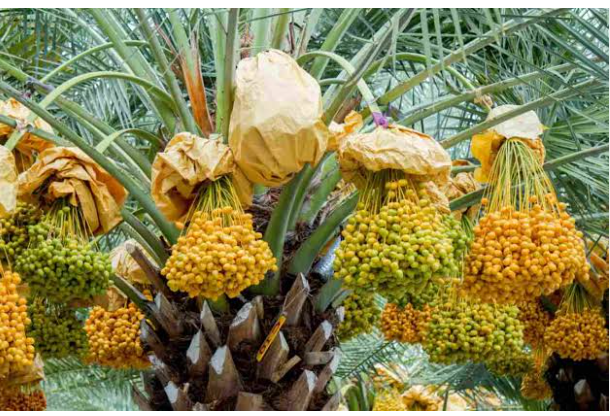
LEAF PRUNING : Pruning in date palm is in general the removal of only dead, or nearly dead fronds and their bases. the leaves do not drop off their own accord, they must then be cut off.
Pruning is desirable in order to improve date fruit quality and also enhance the bearing capacity. In fact, when too many leaves (as many as 180 leaves/palm unpruned for 5 to 6 years) are retained and reaching below level of the fruit bunches, a high percentage of fruit affected with checking and blacknose and of fruit in the dry grades is obtained. Such lower leaves probably compete with the fruit, and create favourable sites for diseases and pests. Removing the leaves up to about the point where the lower ends of most fruit bunches are exposed is highly recommended for adult full bearing palms . It is recommended that leaves which are still green are not pruned so as to take full advantage of photosynthesis.
DETHORNING :
Another important pruning process is the removal of spines, also called thorns. It is advantageous to annually remove spines from the base of new leaves in order to facilitate pollination and handling of fruit bunches. Cut thorns themselves are a source of some danger, because they lodge in leaf bases on the soil where they persist as a hazard.
Some commonly used tools for dethorning include: dethorning knives, a long sharp curved blade or pruning knife mounted on a wooden handle 30 to 45 cm long, or a sickle type blade with a sharp cutting edge.
HARVESTING :
There are specific factors considered before harvesting and packing of the date variety and the form in which they will be consumed.
Harvesting means physically detaching the fruit from the palm. Differences in the state of the fruit, from the point of view of harvesting, are great at the level of spikelets, bunches and palms. These differences can be visible, such as the fruit colour and the degree of ripeness; and invisible, such as the percentage of water and of sugar and the activity of various enzymes are considered.
Whole dates are harvested and marketed at three stages of their development. The choice for harvesting at one or another stage depends on varietal characteristics, climatological conditions and market demand.
The three stages are as follows:
a. Khalal: Physiological mature, hard and crisp, moisture content: 50 – 85 %, bright yellow or red in colour, perishable;
b. Rutab: Partially browned, reduced moisture content (30 – 45 %), fibres softened, perishable;
c. Tamar: Colour from amber to dark brown, moisture content further reduced (below 25 % down to 10% and less), texture from soft pliable to firm to hard, protected from insects it can be kept without special precautions over longer periods.
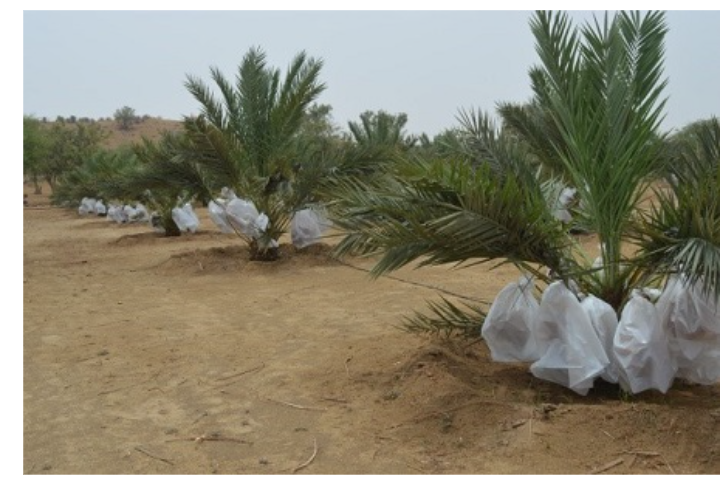
MAJOR PESTS OF DATE PALM
The date palm and its fruits are subject to attacks by several pests that are adapted to the growing environment. Damage caused by thesw pests do lead to heavy economic losses.
A. WHITE SCALE : Caused by Parlatoria blanchardii.
white scale attacks mostly young palms between two to eight years of age, but even under severe attacks, the palm and its offshoots do not die. The nymphs and adults suck the sap from the leafl et, midribs and the dates. Under each scale insect, a discoloured area appears on the leafl et. Heavy infestation causes leafl ets to turn yellow and contributes to the premature death of the fronds. Respiration and photosynthesis are almost stopped resulting in early death of the infested leaf.
CONTROL :
a. Natural enemies and pruning normally keep pest populations at tolerable levels. natural enemies of Parlatoria blanchardii are: Hemisarcoptes malus, Chrysoperla vulgaris, Cardiastethus nazarenus, Coccinellidae spp, Nitidulidae spp, Mycetaeidae spp, Aphytis mytilaspidis, Cybocephalus nigriceps, Cybocephalus rufi frones, Chilocorus bipustulatus.
CONTROL : Spray chemicals
B. RED SCALE ( Phoenicococcus marlatti )
It is a pest of palms, particularly date palms, with other palms as host plants. It is found wherever date palm is cultivated, but with no great threat. The extent of its damage is known to be less than that caused by the Parlatoria scale.
Leaves of date palm are often found to be clotted over with thin, minute, greyish scales with darker centres. The darker spot is oval in outline and is the body of the insect itself. The individual scale is seldom larger than a small pinhead, roundish in shape, and deep pink to dark red in colour, but partly or entirely covered with a white waxy secretion that forms a cottony mass.
All exposed portions of the palm can be attacked by the pest. Heavy infestations could cause complete coverage of the leaf surfaces by scales, which will result in interference with the metabolic functions of the plant.
The red date scale usually stays out of the light and is found massed on the white tissues at the bases of the leaves and fruitstalks, where it is protected by fibre and other leaf bases. Frequently, the scale is found on roots underground. The red scale is not as easily detectable as most other scales because of its natural
CONTROL: The first control measure is to cut away all attacked leaves and burn them in order to stop the spread of the pest. Infested palms, offshoots or even tissue culture-derived plants, which are still at the hardening phase, must be sprayed with malathion 370 – 450 g or with parathion 120 g a.m. dissolved in 450 litres of water.
Since the scale is a sucking insect, the use of ultracide or dimenthoate when the pest is mobile is also recommended. Infested offshoots could also be subjected to a temperature of 50°C for 65 hours in an insulated room.
C. CAROUB MOTH: Caroub moth, also called “Ver de la Datte” in French, is caused by Ectomyelois ceratoniae. It is found in all date growing areas. The larva of the Caroub moth attacks dates in plantations, packing houses and stores. Eggs are laid on the dates and hatching begins four days later. The larval period is about three weeks in warm months and eight weeks in colder months. The pupal period is about five days.
CONTROL : The rate of infestation could be lowered by spraying the infested fruits with Bacillus thuringiensis.
D. RHINOCEROS BEETLE (Oryctes rhinoceros Linné)
The adults feed on tender leaves, inflorescences and fruit stalk of the fruit bunches of date palm, whereas the grubs thrive on decomposing dung and decaying vegetable matter like stumps and trunks of palms. This insect is also a pest of coconut and other palms
Contrary to other pests, only the adult beetles are responsible for causing damage to the palms. The pest has been found to be more destructive to young plants. They remain hidden during the daytime and become active at night, when they fly about and reach the tops of date palms. They drill large holes close to the base of the growing heart-leaf and enter the stem. They feed on the softer tissues of the growing heart-leaf and cut right through it, with the result that further growth stops and the palm ultimately dies. The beetle also causes damage by boring into tender fronds, chewing tissues and throwing them out as a fibrous dry mass . Fronds may hence break and if the growing point is bored the plant dies off. Most of the damage occurs during the rainy season.
CONTROL : The adult beetles should be attracted and destroyed by putting up mercury-vapour light traps at regular intervals in infested plantations
The light trap is based on the fact that some insects are very active at night and are attracted by the light. This method of mechanical control is presently included in Integrated Pest Management.
E. RED PALM WEEVIL AND AFRICAN PALM WEEVIL
The red palm weevil (RPW), Rhynchophorus ferrugineus, is also called the Indian palm weevil, The APW is suspected to originate from a local palm host commonly called Lala Palm (Hyphaene coriacea).
Infestation is often not apparent until extensive damage has already been caused and the palms are beyond recovery. They damage and cause a characteristic rotting odour smell. They also bore small round holes at the base of offshoots. When they chew up date palm fibres, a brown fluid do ooz out of the holes on the stem.
CONTROL : Quarantine, plantation sanitation, chemical treatment, regular surveys, pheromone mass trapping and the use of nematodes. Furthermore, the control of the red and African palm weevils requires all these steps which are of equal importance.
F. RODENTS : Two types of rodents cause damage to date palm: The black rat (Rattus rattus) and the house mouse (Mus musculus L).
The black rat and the house mouse are usually field and storage pest of dat, and. They feed exclusively on date fruits.
They feed on offshoot roots and on roots of old palms causing them to fall down if feeding was only on one side of the palm
They also feed on newly emerge inflorescences.
CONTROL : There is only one control measure, that is by using poison. A mixture of zinc phosphate at 30 to 50 g with 1 kg of millet fl our and 3 % of cooking oil. The paste is to be placed around the palms base.
Others pests of date palm include:
a. Fig Beetle, also called Green Fruit Beetle, Cotinis texana
b. Indian Meal Moth, Plodia interpunctella.
c. Almond Moth, Ephestia calidella;
d. Lesser Date Moth also called Hmira, Batrachedra amydraula.
e. Dubas, Ommatissus binotatus var. Lybicus, De Bergevin
f. Raisin Moth, Cadra figulilella,
g. Arenipses sabella Haps;
h. Stem Borer, Jebusaea hammerschmidtii
i. Fruit Stalk Borer, Oryctes elegans;
j. Frond Borer, Phonopate frontalis, fahraeus;
k. Date Stone Beetle, Coccotrypes dactyliperda
l. Apathe monachus Fabricius; etc.
DISEASES OF DATE PALM
FUNGAL DISEASES OF DATE PALM
1. BAYOUD DISEASE : It causes whitening of the fronds of diseased palms
CAUSATIVE AGENT : Fusarium oxysporum forma specialis albedinis
DISEASE SYMPTOMS :The bayoud disease attacks mature and young palms, as well as offshoots at their base
2. BLACK SCORCH DISEASE : Black scorch, is also called Medjnoon or Fool’s disease
CAUSATIVE AGENT: Ceratocystis paradoxa which is the perfect form of Thielaviopsis paradoxa.
SYMPTOMS : The symptoms are expressed in four distinct forms: black scorch on the leaves, inflorescence blight, heart or trunk rot and bud rot on palms of all ages. Infections are all characterised by partial to complete necrosis of the tissues. Typical lesions are dark brown to black, hard, carbonaceous, and, as a mass, give the petioles, fruit strands and fruit stalks a scorched, charcoal-like appearance
3. BROWN LEAF SPOT :
CAUSATIVE AGENT: Mycosphaerella tassiana . SYMPTOMS : Dark lesions show on green leaves, and on dying leaves the margin of the lesion remains reddish/brown as the centre becomes pale. Lesions also occur on the rachis, pinnae and spines
TREATMENT : Because it is a minor disease, no treatment is recommended. However, annual pruning of old infected leaves and their immediate burning is advised.
4 DIPLODIA DISEASE :
CAUSATIVE AGENT: Diplodia phoenicum
SYMPTOMS : The symptoms are severe on offshoots and are characterised by death either while they are still attached to the mother palm or after they have been detached and planted out. The fungus may infect the outside leaves and fi nally kill younger leaves and the terminal bud, or the central cluster may be infected and die before the older leaves. Yellowish-brown streaks extend along the leaf base
PRECAUTION : Disinfect all tools and cut surfaces. Dipping or spraying the offshoots with various chemicals (benomyl, Bordeaux mixture, methylthiophanate, thiram and other copper-based fungicides), has been found effective against the disease
5.KHAMEDJ DISEASE
CAUSATIVE AGENT: Mauginiella scattae SYMPTOMS : The first visible symptom of the disease appears on the external surface of unopened spathes and is in the form of a brownish or rusty-coloured area. It is most apparent on the internal face of the spathe where the fungus has already begun to infect the infl orescence. When the infected spathes split, they reveal partial or complete destruction of the flowers and strands. Severely damaged spathes may remain closed and their internal contents may be completely infected. The inflorescences become dry and covered with powder.
TREATMENT FOR THE DISEASES
1. Use of chemicals eliminate pathogen
2. Use of cultural methods to distroy pathogen
3. Prophylactic measures
4. Good sanitation practices
5. Quarantine etc.
